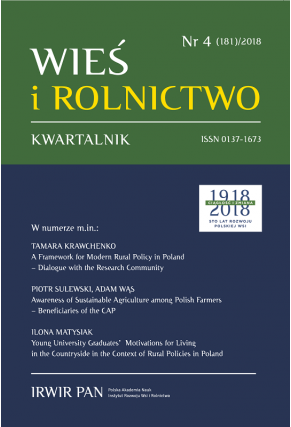The Relationship of Investments and Subsidies to Labour Productivity in Agriculture in Poland between 2010 and 2015
DOI:
https://doi.org/10.53098/wir042018/02Keywords:
investments, subsidies, labour productivity, farms, agricultural policyAbstract
Following the microeconomic producer theory as a framework, this paper studies the empirical relationship between investments and subsidies from the CAP and labour productivity on farms, thus also on whole agriculture sector. It refers to labour productivity as the basis of producers’ income and the investments affecting the capital endowment as a major source of productivity improvement. The aim of the article is to present analytical and empirical evidence of the positive relationship to labour productivity of the growth of investments as well as subsidies on investments. The multifactor ANOVA models with interactions are used as an applied research tool to assess the differences in labour productivity, for example by investments and subsidies on investments. The results obtained indirectly suggest that agricultural producers behave rationally as far as the relationship between investment and labour productivity is concerned.
References
Chiang A.C., Wainwright K. (2005). Fundamental Methods of Mathematical Economics. 4th Edition. New York: McGraw-Hill Education.
Dorward A. (2013). Agricultural labour productivity, food prices and sustainable development impacts and indicators. Food Policy, 39, 40–50. DOI: https://doi.org/10.1016/j.foodpol.2012.12.003
Gelman A., Hill J. (2007). Data Analysis Using Regression and Multilevel/Hierarchical Models. New York: Cambridge University Press. DOI: https://doi.org/10.32614/CRAN.package.arm
Krugman P., Wells R. (2013). Microeconomics. 3rd Edition. New York: Worth Publishers.
Latruffe L. (2010). Competitiveness, Productivity and Efficiency in the Agricultural and Agri-Food Sectors. OECD Food, Agriculture and Fisheries Working Papers 30. Paris: OECD Publishing.
Mary S. (2013). Assessing the impacts of Pillar 1 and 2 subsidies on TFP in French crop farms. Journal of Agricultural Economics, 64 (1), 133–144. DOI: https://doi.org/10.1111/j.1477-9552.2012.00365.x
Michalek J., Ciaian P., Kancs d’A. (2014). Capitalization of the single payment scheme into land value: generalized propensity score evidence from the European Union. Land Economics, 90 (2), 260–289. DOI: https://doi.org/10.3368/le.90.2.260
Nilsson P. (2017). Productivity effects of CAP investment support: Evidence from Sweden using matched panel data. Land Use Policy, 66, 172–182. DOI: https://doi.org/10.1016/j.landusepol.2017.04.043
Pawłowska A., Bocian M. (2017). Estymacja wpływu polityki rolnej na wydajność pracy z wykorzystaniem propensity score matching. Monografie Programu Wieloletniego 2015–2019, 50. Warsaw: Instytut Ekonomiki Rolnictwa i Gospodarki Żywnościowej-Państwowy Instytut Badawczy.
Pejin D. (1971). Discussion. In Heady E.O. (ed.), Economic Models and Quantitative Methods for Decisions and Planning in Agriculture. Proceedings of an East-West Seminar, Iowa. Ames: The Iowa State University Press.
Ratinger T., Medonos T., Hruska M. (2013). An assessment of the differentiated effects of the investment support to agricultural modernisation: The case of the Czech Republic. AGRIS On-line Papers on Economics and Informatics, 5, 153–164.
Rembisz W., Sielska A. (2014). Renta polityczna a inwestycje oraz relacje wynagrodzenia i wydajności czynnika pracy u producentów rolnych. In: Kowalski A., Wigier M., Wieliczko B. (eds.), WPR a konkurencyjność polskiego i europejskiego sektora żywnościowego, (pp. 15–27). Monografie Programu Wieloletniego 2011–2014, 146. Warsaw: Instytut Ekonomiki Rolnictwa i Gospodarki Żywnościowej-Państwowy Instytut Badawczy.
Rembisz W., Sielska A., Bezat-Jarzębowska A. (2014). Agricultural policy and the decisions of agricultural producers as to income and investment. Monografie Programu Wieloletniego 2011–2014, 102.1. Warsaw: Instytut Ekonomiki Rolnictwa i Gospodarki Żywnościowej - Państwowy Instytut Badawczy.
Sckokai P., Moro D. (2009). Modelling the impact of the CAP Single Farm Payment on farm investment and output. European Review of Agricultural Economics, 36 (3), 395–423. DOI: https://doi.org/10.1093/erae/jbp026
Sielska A., Pawłowska A. (2016). Szacowanie efektu oddziaływania polityki rolnej na wartość dodaną z wykorzystaniem propensity score matching. Monografie Programu Wieloletniego 2015–2019, 25. Warsaw: Instytut Ekonomiki Rolnictwa i Gospodarki Żywnościowej - Państwowy Instytut Badawczy.
Stiroh K.J. (2001). What drives productivity growth? Economic Policy Review, 7 (1), 37–59.
Zhu X., Lansink A.O. (2010). Impact of CAP subsidies on technical efficiency of crop farms in Germany, the Netherlands and Sweden. Journal of Agricultural Economics, 61, 545–564. DOI: https://doi.org/10.1111/j.1477-9552.2010.00254.x











